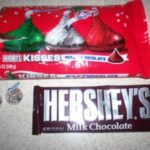Candy has always meant big business in America, but it would take a specific kind of candy to really capture the imagination of sweet tooths everywhere and create a money-making machine. The very first Hershey Bar appeared in 1894 and it heralded a sweeping movement that has never shown signs of slowing down and that has been tinkered and tampered and experimented with in nearly every possible way. Milton Hershey lived the American dream by using nothing more extravagant or innovative than good old-fashioned sugar, milk, and cocoa. That very first Hershey Bar, which has essentially remained unchanged, cost members of the Gilded Age just a few cents; more than penny candy, of course, but the return was worth the investment. The chocolate bar revolution had begun.
Hershey soon discovered the dark side of capitalism however as he almost immediately faced competition in the form of a small drop of chewy chocolate dressed in a wrapper and named after his daughter, Tootsie. The Tootsie Roll became a hit just as quickly as the Hershey Bar thanks to the fact that they were so small they could be carried around inside a pocket or purse. The overnight sensations from Hershey and Lenny Hirschfield had the effect of creating the same kind of rush to quick bucks from imitators that marks the success of any new product in America. Before too long many of the chocolate bars that we are still familiar with today were being bought by the millions.
In 1921 a chocolate bar appeared with the unique addition of coconut to its ingredients called Mounds. The same man who invented the Mounds, the chocolate bar for those who sometimes don’t feel like a nut, produced Almond Joy in 1947, the chocolate bar for those who sometimes feel like a nut. 1921 also saw the introduction of perhaps the most misunderstood candy bar of all time, the Baby Ruth. It was one of those strange quirks of fate that the Baby Ruth bar came along just at the same time that Babe Ruth was revolutionizing how the game of baseball was played and became the most popular celebrity in the country. Every generation produces another fan of the Baby Ruth candy bar who labors under the quite understandable misassumption that the chocolate bar that was most successful at adding caramel into the mix was named after the Bambino. In fact, the candy bar was named by its inventor Otto Schnering to honor-in some strange way-the daughter of former President Grover Cleveland, Baby Ruth Cleveland. What even most people who do know this fact aren’t aware of is that Otto Schnering’s claim to fame only begins with his confusing choice for a name for his first famous candy bar, but it ends with his other contribution to the history of the chocolate bar, Bart Simpson’s favorite, Butterfinger.
Despite the fact that it is the Hershey Bar that is perhaps the chocolate bar most people immediately think of, the most successful man in the business of making America’s favorite candy was not Milton Hershey, but Franklin Mars. The very first chocolate bar that Franklin Mars marketed was the Milky Way which after just two years was bringing his company revenues of nearly a million dollars smack dab in the middle of the Great Depression. Not content merely to sit on that kind of success, over the years Mars followed up the Milky Way bar with Snickers and 3 Musketeers before finally achieving true genius by devising a way to eat chocolate that melted in your mouth, but not in your hand.



